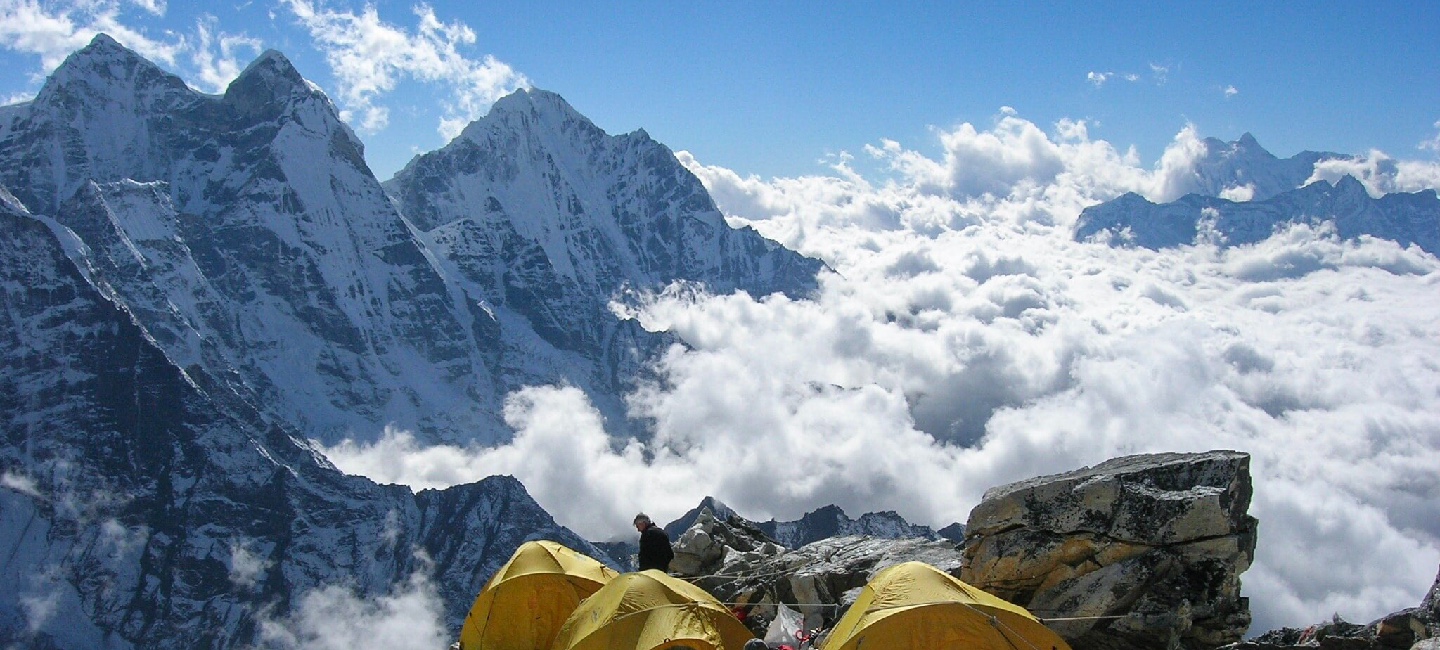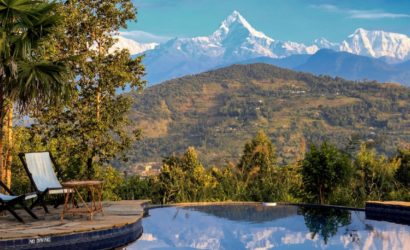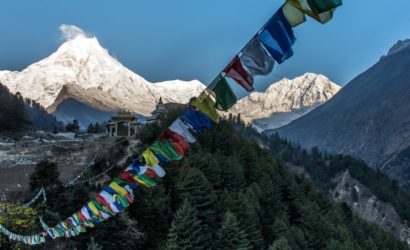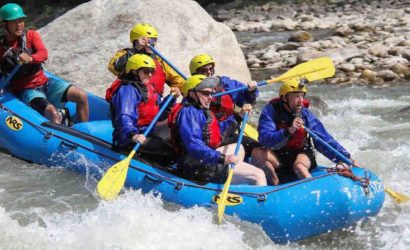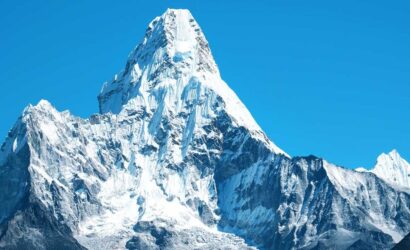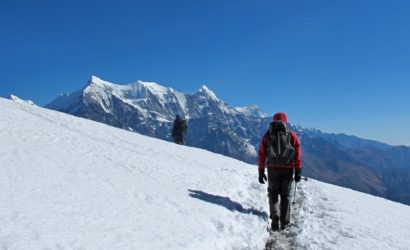Ama Dablam 6,856 meters (22,494ft) is one of the most stunning peaks in the Himalaya and one of the most impressive mountains in the world.
It is located the heart of Everest’s Khumbu region, it lies directly above Tengboche Monastery on the well-worn path to Everest Base Camp and is admired by thousands of trekkers and climbers every year. Ama Dablam Expedition offers a superb, technical climbing experience in a magnificent setting, with numerous cultural and scenic diversions.
Like the Matterhorn in the Swiss Alps, Ama Dablam epitomizes all that is grand about the mountains. It’s striking features have become a familiar figure to the public through its adoption as the logo of ‘Perpetual’, an international assurance company, and numerous posters and books throughout the world.
Such impressive beauty has made Ama Dablam a highly coveted prize for climbers. Since its first ascent in 1961 by an Anglo-American-New Zealand team, it has been climbed frequently and by many different routes.
Our route for Ama Dablam Expedition will be by the original line of ascent, the South West Ridge. This gives a fine and varied climb, sustained at a reasonable level of difficulty and with good camp platforms at strategic points. The climbing provides interest on rock, snow and ice and although of a fairly technical nature, in normal conditions it is never very difficult. Apart from one short section, the climb is objectively very safe.
If you have the necessary experience and wish to participate fully as a team member of an expertly led expedition to one of the world’s most impressive mountains, this could be the trip for you.
Experience Required for Ama Dablam Expedition
- With some experience on snow and ice, you must be experienced in climbing in all weather conditions.
- You have to be able to climb on your back with an alpine bag.
- Experience with conditions of high altitude and camping is ideal.
- Past climbing experience of 7000-meter peak climbing highly recommended.
- You must be in excellent physical health and have trained for this trip with a rigorous training program for at least half a year before the expedition.
For more information about fitness levels, please contact us for further discussion. This is the most important thing you can do to prepare for your expedition.
Upon your arrival in the Kathmandu airport after completing your custom formalities Visa, etc. pick up your luggage and look for our airport representative from Himalaya Discovery Adventures, who will display your name on the board at the arrival gate.
You will be greeted by our representative and transferred to the hotel by private tourist vehicle. Overnight at hotel in Kathmandu.
Today is free for sightseeing in Kathmandu. You may wish to visit Durbar Square in the heart of the old city where the old Royal Palace, with its intricate woodcarving is located. The whole area is a maze of temples and images. Leading away from the square in all directions are narrow alleys, full of the most amazing variety of shops and stalls.
Some of these landmarks are considered World Heritage Sites including the historic Bhaktapur Durbar Square, the famous ‘Monkey Temple’ Swayambhunath and Buddhists shrine Buddhanath which is one of the largest Stupas in the world.
There will also be a full trip briefing today with gear check. In case you need to hire or buy equipment locally there will be time to do this today. Overnight at hotel in Kathmandu.
Formal briefing in the Ministry of Tourism. Today, the expedition leader will also check everyone’s equipment. The last opportunity to buy anything missing, overnight at hotel.
An early morning start takes us to (TIA) Airport in Kathmandu for the 35 minute scenic flight to Tenzing and Hillary Airport at Lukla at 2804 meters. On arrival at the airport guide will brief you and introduce our porters before we begin our trek towards Phakding.
After landing we have time to discover the village while our staff sort and load our trekking equipment. Then we begin our trek by descending towards the Dudh Kosi River where we join the main trail to Namche Bazaar, located just above Chaurikharka (2713 meters).
The walking is easy and after passing through the small village of Ghat (2550 meters) it is a short walk to Phakding, It is important to take these first few days slowly to enable your body to acclimatize and to enjoy the passing scenery and culture. Overnight at guesthouse.
We continue trekking along the banks of the Dudh Kosi, crossing this majestic river many times on exciting suspension bridges laden with prayer flags. After entering Sagarmatha National Park, the trail climbs steeply with breathtaking views.
Namche Bazaar known as the Gateway to Everest which is home to many quality restaurants, hotels, lodges, shops, Money exchange, internet cafe and a bakery. Namche is one of the biggest villages along the whole Everest trail.
We will spend a day here in order to acclimatize and adjust to the thinning of the air. As well as a short trek where a museum is celebrating the traditional customs of the Sherpa people.
Today, we hike up the Syangboche Airport around Everest View Hotel. From this point, we can see rewarding views of the Himalayas with a stunning sunrise and sunset over the panorama of Khumbu peak.
The trek continues along the rushing glacial waters of the Dudh Kosi with magnificent views of the mountains. We trek to an altitude of 3860meters today.
On reaching Tengboche you will see the local monastery. Inside the monastery are incredibly ornate wall hangings, a 20-foot sculpture of Buddha, and the musical instruments and robes of the Lamas.
The group will be taken to observe a prayer ceremony either in the evening or morning depending on how the days trekking went.
From Tengboche, the trail drops to Debuche, crosses another exciting suspension bridge on the Imja Khola, and climbs to Pangboche amongst thousands of mani stones.
Our uphill trek continues, taking us to the quaint traditional Sherpa village of Pangboche with its exquisite views of Lhotse, Island Peak, and Ama Dablam. We take our time so we avoid getting affected by the altitude.
Base camp is located in an idyllic spot from which the majority of the route is visible. At an altitude of about 4,600 m, it provides a comfortable escape from the rigors of the climb. Our porters deposit their loads and leave us here for the next three weeks, with only our Sirdar, Sherpas and culinary staff remaining.
Training Day – Fixed Lines / Traverse / Summarizing the techniques
We do not provide a prescriptive day-to-day itinerary for the climb, as this will be decided by the expedition leader and member. They will take a flexible approach based on their own experience.
Typically, the team will spend a few days at base camp organizing food, practicing rope skills and acclimatizing before moving above base camp. It is normal to ‘tag’ or spend at least one night in camp 1 (5,700 meters) as part of any acclimatization schedule, before returning to base camp, resting and preparing for a summit push.
Ama Dablam Climb via South West Ridge
After base camp 4,600meters old grassy moraine ridges are followed roughly eastwards to a broad saddle 5,150meters from where we can see the Mingbo La. From the saddle we ascend easily northwards until the ground steepens at the start of a large boulder field. It is possible to place an Advanced Base Camp at 5,400meters below the boulder field. The route continues in a northwards direction around the base of the boulder field, and then follow cairns upwards towards the toe of the SW ridge. Camp 1 should now be visible just below Pt. 5,705meters. At the end of the boulder field, slabs are crossed and then a short gully ascended, which allows access to the ridge proper in a very exposed position. Easy scrambling on the east side of the ridge leads quickly to Camp. There are four or five tent platforms.
From Camp 1 we continue our round the snowy bowl (possible alternative site for Camp 1) until below two rock fingers. The east side of the ridge is followed, climbing easy mixed ground until a short pitch of severe standard leads to the ridge proper. The ridge is narrow in places, turning difficulties on the east side, until the second tension traverse leads to two pitches of Very Severe standard. The route continues on the crest of the ridge for a short distance until we are forced via an awkward step onto the west side of the ridge. The crest of the ridge is regained and easy ground followed to the start of a traverse on the east face, which leads to the Yellow Tower. This 15meter pitch, which is just below Camp 2, is one of the hardest pitches on the climb at HVS (5.8) standard. A short section of ridge now leads to Camp Two 5,900meters. Camp Two has very limited tent space (3 or 4 tents platforms) and is extremely exposed. It is sometimes only used as an equipment dump with expeditions choosing to go from Camp I to Camp III in a single push.
From Camp Two, the climb skirts a red rock bluff on the east and after a step down, follows the snow ridge direct to an awkward traverse eastwards which leads to a gully between the Grey Tower and the lower rock buttress. We climb the gully until a very exposed traverse line is reached on the west side of the ridge. A short snow slope is ascended to the start of the Mushroom Ridge. This is followed and typically involves negotiating some steep snow sections, until Camp III 6,300meters is reached .
The route climbs the snow and ice slope directly above Camp III and to the right hand side of the Dablam. We continue to skirt the Dablam on the right side and then move westwards to gain a small snowfield below the Burgschrund. The Burgschrund is crossed and then the climb heads directly to the obvious ice crest. This is followed in a magnificent position to the summit.
We descend to Namche bazar. If we are lucky, it will be market time in Namche. Regardless, there is always fabulous food to be found, including real espresso, yak steaks and chocolate cake with frosting!
This market is where lowland porters bearing supplies meet the highland Sherpa and Tibetan people who have journeyed over high passes from many miles away to trade food and supplies for their home or village. Enjoy and celebrate your expedition.
Finally, we return to Lukla where the trek began, which will seem like a lifetime ago. Enjoying time to reflect on the trek as a group and the personal achievement of all those who took part. Also giving you time to explore the town.
Enjoying your last glimpse of the mountains you have recently visited for one last time on the 35 minute Scenic flight back to Kathmandu.
On arrival in Kathmandu we are met and transferred back to hotel.
This is also a buffer day in case our Lukla flight is delayed. If we fly out of Lukla on time we have a full day to relax and enjoy the various delights of Kathmandu.
In the evening celebrate the expedition and as a farewell party to thank the Sherpas and the team member for their support and friendship during the expedition with the hope of seeing you all again for next expedition!.
This is also a buffer day in case our Lukla flight is delayed. If we fly out of Lukla on time we have a full day to relax and enjoy the various delights of Kathmandu.
In the evening celebrate the expedition and as a farewell party to thank the Sherpas and the team member for their support and friendship during the expedition with the hope of seeing you all again for next expedition!.
Today is rest and relax throughout the day or say goodbye to Nepal. Enjoy your final moments in Kathmandu with a city stroll or souvenir shopping.
Enjoy your last moments in Kathmandu with breakfast in a café, a city stroll, and/or souvenir shopping.
A representative will meet you at your hotel and drive you to the airport for your return flight home. It’s good to be at the airport at least 2 and half hours prior to departure.

